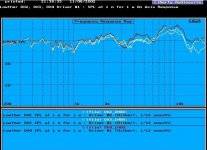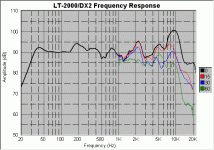 good one.
good one. Jokes aside, GM answered the OP's question pretty well.
thisisvv: Were the traits of the Lowther you admired: lifelike dynamics and detail, and a general sense of realism?
I still think the F200A is a reasonable choice, assuming it sounds kind of like the old FX200 but better. As has been pointed out, even that in the recommended BR is much bigger than what would normally be considered desktop speakers. Furthermore, it probably would truly be at its best in something bigger than the factory BR. There's always the F120A.
The problem as I see it is - bigger really is better.
Another thing to consider is that the system is only as good as the weakest link. Really resolving speakers can make sub par gear sound like cats fighting.
What claims are people objecting to?
The claimed performance of the small stand-mount.
dave
I've used the DX3. Put it in an MLTL that has been moderately successful. The only way you can get 101dB/w/m out of a DX3 with every a modest bandwidth is a front horn. Look at an FR plot of the DX3. The only time it gets anywhere near 101dB is that huge hump peaking at 8kHz. My speakers have a rather aggressive filter to tame the peak and, of course, BSC is required. The real SPL on a TQWT/MLTL is 90-92dB/w/m.
Bob
Bob
I've used the DX3. Put it in an MLTL that has been moderately successful. The only way you can get 101dB/w/m out of a DX3 with every a modest bandwidth is a front horn. Look at an FR plot of the DX3. The only time it gets anywhere near 101dB is that huge hump peaking at 8kHz. My speakers have a rather aggressive filter to tame the peak and, of course, BSC is required. The real SPL on a TQWT/MLTL is 90-92dB/w/m.
Bob
with such end results, it's not hard to imagine any of several models of far more affordable raw drivers which have a lot of traffic on these forums as providing a much more practical solution for a desk top situation
in no particular order
Fostex FF85WK
Alpair 6P
Alpair 7.3
CHR70.3
TangBand - any of several W4 series
Fountek FR85s
I've heard all of the above except for the TBs in exactly this type of application, and my personal favorite so far would be the 85WK
The only time it gets anywhere near 101dB is that huge hump peaking at 8kHz.
Yeah, even though they're rating them at the 1 kHz mid-band efficiency point, the most efficient measured responses of any Lowther I've seen only manages ~98 dB/W/m.
GM
I was just perusing my experiment measurements from over the years, and discovered that I had tried to do this very thing myself: make a small Lowther speaker.
Now I am a terrible dabbler with ideas, and my records are pretty incomplete. BUT I did get the following measurements in room from a test disc.
Hz 50 63 80 100 125 160 200 250 320 400 500 630 800 1k 1.25 1.6 2.0 2.5 3.2 4 5 6.3
dB 59 67 73 72 68 69 64 65 61 65 64 64 65 63 65 72 73 72 69 67 64 63
The peak in the 1.6-3.2k range is inherent in uncorrected Lowther drivers.
The design was simply a 10 litre closed box with a Monacor sph 135 AD. On the front of that I had a shallow (7cm with PM6C) backless box with the Lowther drive unit. So the back of the Lowther and the front of the 135 AD fired into the same volume. A sort of semi isobaric design. If you visualise the lowther magnet being right in front of the Monacor you have got the idea. The lowther had an L pad, which I ended up setting at -8dB.
There are obviously a lot of issues with the design. Firstly you lose 8dB on the Lowther. Secondly to what extent is the Monacor "driving" the Lowther at lower frequencies? The Lowther has very limited xmax and so high volume is a complete no-no.
I did not make a note but I suspect I would have used one channel for each driver (it was only a one off prototype), what effect connecting the drivers in parallel would have I do not know.
It is not an Isobaric design, and indeed I preferred the sound with some small holes in the corners of the Lowther baffle.
The good thing about this is if you have a speaker with at least a 8" wide flat baffle, and an Lpad (variable is best) you can knock up the backless Lowther in less than an hour, and just plonk it on the baffle of your speaker to cover the drivers, (or just the main driver, and cover over the tweeter to stop any output.) Just to try it out I would suggest doing it with the speaker on it's back so that you do not need to screw anything to anything else.
The design was too deep for what I wanted so I did not pursue it. It also worked with a smaller ported speaker.
I made no note of what it sounded like unfortunately. Hopeless.
Now I am a terrible dabbler with ideas, and my records are pretty incomplete. BUT I did get the following measurements in room from a test disc.
Hz 50 63 80 100 125 160 200 250 320 400 500 630 800 1k 1.25 1.6 2.0 2.5 3.2 4 5 6.3
dB 59 67 73 72 68 69 64 65 61 65 64 64 65 63 65 72 73 72 69 67 64 63
The peak in the 1.6-3.2k range is inherent in uncorrected Lowther drivers.
The design was simply a 10 litre closed box with a Monacor sph 135 AD. On the front of that I had a shallow (7cm with PM6C) backless box with the Lowther drive unit. So the back of the Lowther and the front of the 135 AD fired into the same volume. A sort of semi isobaric design. If you visualise the lowther magnet being right in front of the Monacor you have got the idea. The lowther had an L pad, which I ended up setting at -8dB.
There are obviously a lot of issues with the design. Firstly you lose 8dB on the Lowther. Secondly to what extent is the Monacor "driving" the Lowther at lower frequencies? The Lowther has very limited xmax and so high volume is a complete no-no.
I did not make a note but I suspect I would have used one channel for each driver (it was only a one off prototype), what effect connecting the drivers in parallel would have I do not know.
It is not an Isobaric design, and indeed I preferred the sound with some small holes in the corners of the Lowther baffle.
The good thing about this is if you have a speaker with at least a 8" wide flat baffle, and an Lpad (variable is best) you can knock up the backless Lowther in less than an hour, and just plonk it on the baffle of your speaker to cover the drivers, (or just the main driver, and cover over the tweeter to stop any output.) Just to try it out I would suggest doing it with the speaker on it's back so that you do not need to screw anything to anything else.
The design was too deep for what I wanted so I did not pursue it. It also worked with a smaller ported speaker.
I made no note of what it sounded like unfortunately. Hopeless.
Bob. That's interesting. Because that curve bears no relation to my measurements. As my previous offering showed I get a big peak at 2.5k. Looking at my other measurements I also have a second peak at 10k. This is a couple of dB down on the lower peak. My immediate thought was "cheap equipment", but that is how it sounded too. Then I remembered a speaker manufacturer measured a Lowther design of mine. Their equipment was top quality, and it agreed with my measurements. My drive units are PM6Cs with silver voice coils, and my measurements were at least 20 years ago. Not quite sure what this all means
Your curves from the DX2 are certainly different from my PM6C. From what I read on the net by enthusiasts, the different drivers evoke strong opinions. Lowther the company maintain that their more recent models are superior. The enthusiasts don't agree, and seem to go for older models, particularly the Alnico models. I completely agree that with your DX2s that hf peak is not acceptable.
I must also add that that MLTL measures as well as any Lowther based speaker I have seen. Really impressive. Shame about the upper frequencies.
I must also add that that MLTL measures as well as any Lowther based speaker I have seen. Really impressive. Shame about the upper frequencies.
so i am confused it can be done or not???
I think so. Apart from using equalization, I have had some luck with the 6 1/2
inch Lowthers in small sealed boxes (1/2 cf or so) and driven by current
sources or other high impedance output amplifiers. The impedance peak gives
rise to improved bass, and you can easily adjust the top end with an RC
network to load the output. You probably don't have a current source amp,
but you can stick an 8 ohm resistor in series with the output to get most of
what you might need.
The article on current source amplifiers and full range speakers deals with the
example of a DX55: FIRST WATT
The sound that came out of this one was quite acceptable.
All this said, the Jordan J92 works very well in a little box on a desk.
Last edited:
Agreed, it's certainly possible if you select the right unit (higher Q type if a high output impedance amp isn't used) & are prepared to use some Eq. They're not the drivers that automatically leap to mind for such roles, but it can be done if you are prepared to put the work in.
I believe so.

can you guide me to some digrams of cabinets i should look for desktop system
and as you told earlier adding a 8 ohm resistor should get me some High current amp from a voltage amplifier...
V
Take a lot at Horst Moeller's website, lots of interesting backloaded horns, some of astonishingly small size.
Lowthers beam. Like crazy. Maybe pointing it up and putting a reflector above it would be a good idea for desk use. I always loved my Lowthers in fronthorns, but these would obviously be too deep.
Lowthers beam. Like crazy. Maybe pointing it up and putting a reflector above it would be a good idea for desk use. I always loved my Lowthers in fronthorns, but these would obviously be too deep.
- Status
- This old topic is closed. If you want to reopen this topic, contact a moderator using the "Report Post" button.
- Home
- Loudspeakers
- Full Range
- Lowther for desktop use

